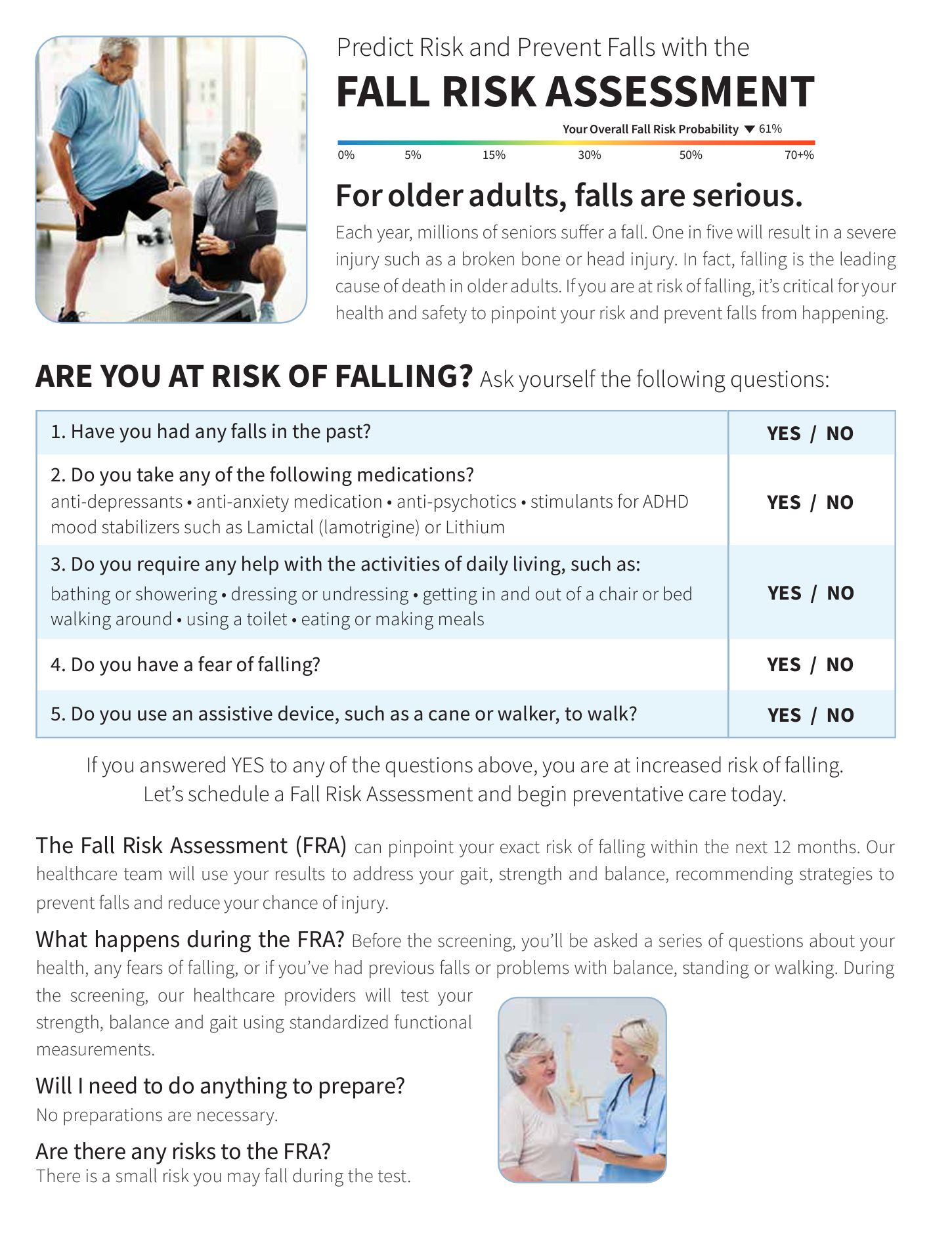Things about Dementia Fall Risk
Things about Dementia Fall Risk
Blog Article
How Dementia Fall Risk can Save You Time, Stress, and Money.
Table of ContentsEverything about Dementia Fall RiskThe smart Trick of Dementia Fall Risk That Nobody is Talking AboutDementia Fall Risk Can Be Fun For EveryoneSome Of Dementia Fall Risk
A loss danger assessment checks to see exactly how likely it is that you will drop. It is primarily provided for older grownups. The analysis usually includes: This consists of a collection of inquiries regarding your total health and if you've had previous falls or issues with balance, standing, and/or strolling. These tools examine your toughness, equilibrium, and gait (the means you walk).Treatments are recommendations that might decrease your risk of falling. STEADI consists of three actions: you for your risk of falling for your risk elements that can be boosted to try to protect against falls (for instance, balance problems, damaged vision) to lower your danger of dropping by making use of reliable methods (for instance, offering education and learning and resources), you may be asked numerous inquiries consisting of: Have you fallen in the past year? Are you fretted about falling?
If it takes you 12 secs or more, it might suggest you are at higher threat for an autumn. This test checks strength and equilibrium.
The settings will get more challenging as you go. Stand with your feet side-by-side. Move one foot halfway ahead, so the instep is touching the big toe of your various other foot. Relocate one foot fully in front of the other, so the toes are touching the heel of your various other foot.
How Dementia Fall Risk can Save You Time, Stress, and Money.
Most drops take place as an outcome of multiple adding aspects; therefore, managing the risk of dropping starts with identifying the factors that contribute to fall danger - Dementia Fall Risk. Several of the most pertinent threat elements consist of: History of previous fallsChronic clinical conditionsAcute illnessImpaired gait and balance, reduced extremity weaknessCognitive impairmentChanges in visionCertain high-risk medications and polypharmacyEnvironmental elements can additionally boost the threat for falls, consisting of: Poor lightingUneven or damaged flooringWet or unsafe floorsMissing or harmed hand rails and order barsDamaged or poorly fitted tools, such as beds, mobility devices, or walkersImproper use of assistive devicesInadequate guidance of the people residing in the NF, consisting of those who exhibit aggressive behaviorsA successful loss risk monitoring program needs a thorough scientific assessment, with input from all members of the interdisciplinary team

The care plan should likewise consist of interventions that are system-based, such as those that promote a safe atmosphere (appropriate lighting, hand rails, get hold of bars, etc). The performance of the treatments must be evaluated periodically, and the treatment plan revised as needed to reflect adjustments in the loss danger evaluation. Executing an autumn risk management system using evidence-based finest practice can reduce the frequency of falls in the NF, while limiting the possibility for fall-related injuries.
Facts About Dementia Fall Risk Uncovered
The AGS/BGS guideline recommends screening all adults matured 65 years and older for fall risk each year. This screening consists of asking people whether they have actually dropped 2 or even more times in the past year or sought clinical attention for get redirected here an autumn, or, if they have not fallen, whether they feel unstable when walking.
Individuals that have actually dropped as soon as without injury needs to have their balance and gait reviewed; those with gait or equilibrium abnormalities ought to get extra evaluation. A background of 1 fall without injury and without gait or balance troubles does not require more assessment beyond continued annual fall threat screening. Dementia Fall Risk. A loss threat assessment is needed as component of the Welcome to Medicare examination

What Does Dementia Fall Risk Do?
Documenting a drops history is one of the top quality indicators for fall avoidance and monitoring. Psychoactive medicines in certain are independent predictors of falls.
Postural hypotension can typically be minimized by reducing the dosage of blood pressurelowering medications and/or stopping medications that have orthostatic hypotension as a negative effects. Use above-the-knee assistance tube and copulating the head of the bed elevated might additionally lower site postural decreases in blood pressure. The advisable components of a fall-focused health examination are shown in Box 1.

A TUG time higher than or equal to 12 seconds recommends high fall danger. The 30-Second Chair Stand test assesses lower extremity toughness and balance. Being not able to stand up from a chair of knee height without using one's arms suggests enhanced fall threat. The 4-Stage Equilibrium test examines fixed equilibrium by having the individual stand in 4 settings, each considerably extra difficult.
Report this page